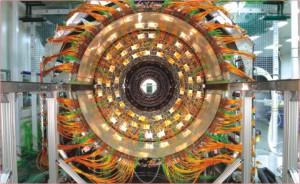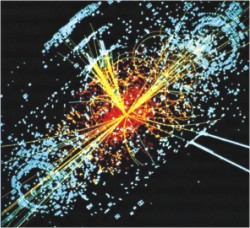| Spotlight
 In search of the Pristine Particle In search of the Pristine Particle
Compiled by Mahdin Mahboob
The LHC Project
The Large Hadron Collider (LHC) is the world's largest and highest-energy particle accelerator complex, intended to collide opposing beams of protons (one of several types of hadrons) with very high kinetic energy. Its main purpose is to explore the validity and limitations of the Standard Model, the current theoretical picture for particle physics. It is theorized that the collider will confirm the existence of the Higgs boson. This would supply a crucial missing link in the Standard Model and explain how other elementary particles acquire properties such as mass.
The LHC was built by the European Organization for Nuclear Research (CERN), and lies underneath the Franco-Swiss border between the Jura Mountains and the Alps near Geneva, Switzerland. It is funded by and built in collaboration with over eight thousand physicists from over eighty-five countries as well as hundreds of universities and laboratories. The LHC is operational and is presently in the process of being prepared for collisions. The first beams were circulated through the collider on 10 September 2008, and the first high-energy collisions are expected to take place 6-8 weeks after that.
Although there have been questions concerning the safety of the Large Hadron Collider in the media and even through the courts, the consensus in the scientific community is that there is no conceivable threat from the LHC particle collisions.
 Design Design
The LHC is the world's largest and highest-energy particle accelerator. The collider is contained in a circular tunnel, with a circumference of 27 kilometres (17 mi), at a depth ranging from 50 to 175 metres underground.
The 3.8 m wide concrete-lined tunnel, constructed between 1983 and 1988, was formerly used to house the Large Electron-Positron Collider. It crosses the border between Switzerland and France at four points, with most of it in France. Surface buildings hold ancillary equipment such as compressors, ventilation equipment, control electronics and refrigeration plants.
The collider tunnel contains two adjacent parallel beam pipes that intersect at four points, each containing a proton beam, which travel in opposite directions around the ring. Some 1,232 dipole magnets keep the beams on their circular path, while an additional 392 quadrupole magnets are used to keep the beams focused, in order to maximize the chances of interaction between the particles in the four intersection points, where the two beams will cross. In total, over 1,600 superconducting magnets are installed, with most weighing over 27 tonnes. Approximately 96 tonnes of liquid helium is needed to keep the magnets at their operating temperature of 1.9 K, making the LHC the largest cryogenic facility in the world at liquid helium temperature.
Superconducting quadrupole electromagnets are used to direct the beams to four intersection points, where interactions between protons will take place.
Superconducting quadrupole electromagnets are used to direct the beams to four intersection points, where interactions between protons will take place.
Once or twice a day, as the protons are accelerated from 450 GeV to 7 TeV, the field of the superconducting dipole magnets will be increased from 0.54 to 8.3 tesla (T). The protons will each have an energy of 7 TeV, giving a total collision energy of 14 TeV (2.2 ìJ).
At this energy the protons have a Lorentz factor of about 7,500 and move at about 99.999999% of the speed of light! It will take less than 90 microsecond (ìs) for a proton to travel once around the main ring a speed of about 11,000 revolutions per second. Rather than continuous beams, the protons will be bunched together, into 2,808 bunches, so that interactions between the two beams will take place at discrete intervals never shorter than 25 nanoseconds (ns) apart. However it will be operated with fewer bunches when it is first commissioned, giving it a bunch crossing interval of 75 ns.
Prior to being injected into the main accelerator, the particles are prepared by a series of systems that successively increase their energy. The first system is the linear particle accelerator LINAC 2 generating 50 MeV protons, which feeds the Proton Synchrotron Booster (PSB). There the protons are accelerated to 1.4 GeV and injected into the Proton Synchrotron (PS), where they are accelerated to 26 GeV. Finally the Super Proton Synchrotron (SPS) is used to further increase their energy to 450 GeV before they are at last injected (over a period of 20 minutes) into the main ring. Here the proton bunches are accumulated, accelerated (over a period of 20 minutes) to their peak 7 TeV energy, and finally stored for 10 to 24 hours while collisions occur at the four intersection points.
Six detectors have been constructed at the LHC, located underground in large caverns excavated at the LHC's intersection points. Two of them, the ATLAS experiment and the Compact Muon Solenoid (CMS), are large, general purpose particle detectors. A Large Ion Collider Experiment (ALICE) and LHCb have more specific roles and the last two TOTEM and LHCf are very much smaller and are for very specialized research. The BBC's summary of the main detectors is:
* ATLAS one of two so-called general purpose detectors. Atlas will be used to look for signs of new physics, including the origins of mass and extra dimensions.
* CMS the other general purpose detector will, like ATLAS, hunt for the Higgs boson and look for clues to the nature of dark matter.
* ALICE will study a "liquid" form of matter called quark-gluon plasma that existed shortly after the Big Bang.
* LHCb equal amounts of matter and anti-matter were created in the Big Bang. LHCb will try to investigate what happened to the "missing" anti-matter. When in operation, about seven thousand scientists from eighty countries will have access to the LHC. It is theorized that the collider will produce the elusive Higgs boson, the last unobserved particle among those predicted by the Standard Model. The verification of the existence of the Higgs boson would shed light on the mechanism of electroweak symmetry breaking, through which the particles of the Standard Model are thought to acquire their mass. In addition to the Higgs boson, new particles predicted by possible extensions of the Standard Model might be produced at the LHC. More generally, physicists hope that the LHC will enhance their ability to answer the following questions:
* Is the Higgs mechanism for generating elementary particle masses in the Standard Model indeed realised in nature? If so, how many Higgs bosons are there, and what are their masses?
* Are electromagnetism, the strong nuclear force and the weak nuclear force just different manifestations of a single unified force, as predicted by various Grand Unification Theories?
* Why is gravity so many orders of magnitude weaker than the other three fundamental forces? See also Hierarchy problem.
* Is Supersymmetry realised in nature, implying that the known Standard Model particles have supersymmetric partners?
* Will the more precise measurements of the masses and decays of the quarks continue to be mutually consistent within the Standard Model?
* Why are there apparent violations of the symmetry between matter and antimatter? See also CP-violation.
* What is the nature of dark matter and dark energy?
* Are there extra dimensions, as predicted by various models inspired by string theory, and can we detect them?
The findings?
Of the possible discoveries the LHC might make, only the discovery of the Higgs particle is relatively uncontroversial, but even this is not considered a certainty. Stephen Hawking said in a BBC interview that "I think it will be much more exciting if we don't find the Higgs. That will show something is wrong, and we need to think again. I have a bet of one hundred dollars that we won't find the Higgs." In the same interview Hawking mentions the possibility of finding superpartners and adds that "whatever the LHC finds, or fails to find, the results will tell us a lot about the structure of the universe."
The first beam was circulated through the collider on the morning of 10 September 2008. CERN successfully fired the protons around the tunnel in stages, three kilometres at a time. The particles were fired in a clockwise direction into the accelerator and successfully steered around it. The LHC successfully completed its first major test: after a series of trial runs, two white dots flashed on a computer screen showing the protons traveled the full length of the collider. It took less than one hour to guide the stream of particles around its inaugural circuit. CERN next successfully sent a beam of protons in a counterclockwise direction, taking slightly longer at one and a half hours due to a problem with the cryogenics.
Once the supercollider is up and running, CERN scientists estimate that if the Standard Model is correct, a Higgs boson may be produced every few hours. At this rate, it may take up to three years to collect enough statistics unambiguously to discover the Higgs boson. Similarly, it may take one year or more before sufficient results concerning supersymmetric particles have been gathered to draw meaningful conclusions.
The upcoming experiments at the Large Hadron Collider have sparked fears among the public that the LHC particle collisions might produce doomsday phenomena, including dangerous microscopic black holes and strange matter.Two CERN-commissioned safety reviews have examined these concerns and concluded that the experiments at the LHC present no danger and that there is no reason for concern, a conclusion expressly endorsed by the American Physical Society, the world's second largest organization of physicists.
The Higg's Boson
The Higgs boson is a hypothetical massive scalar elementary particle predicted to exist by the Standard Model of particle physics. It is the only Standard Model particle not yet observed. An experimental observation of it would help to explain how otherwise massless elementary particles cause matter to have mass. More specifically, the Higgs boson would explain the difference between the massless photon and the relatively massive W and Z bosons. Elementary particle masses, and the differences between electromagnetism (caused by the photon) and the weak force (caused by the W and Z bosons), are critical to many aspects of the structure of microscopic (and hence macroscopic) matter; thus, if it exists, the Higgs boson is an integral and pervasive component of the material world.
No experiment has yet directly detected the Higgs boson; the Large Hadron Collider (LHC) at CERN, which came on line on 10 September 2008, is expected to provide experimental evidence that will confirm or reject the particle's existence.
In electronic media and in many newspapers and magazines, the Higgs boson is frequently referred to as 'the god particle', although it has got nothing to do with religion or anything distantly related to it! This name was adopted after Leon Lederman's book (The God Particle: If the Universe Is the Answer, There is no question) which enjoyed wide popularity. In fact this is also a code name for the familiar expression 'the goddamn particle' which working physicists frequently used in desperation for this elusive particle.
Information and image sources: Wikipedia, IEEE Spectrum, New Scientist Magazine, Cosmos Magazine, AFP, BBC, CERN and other websites.
Copyright
(R) thedailystar.net 2008 |

